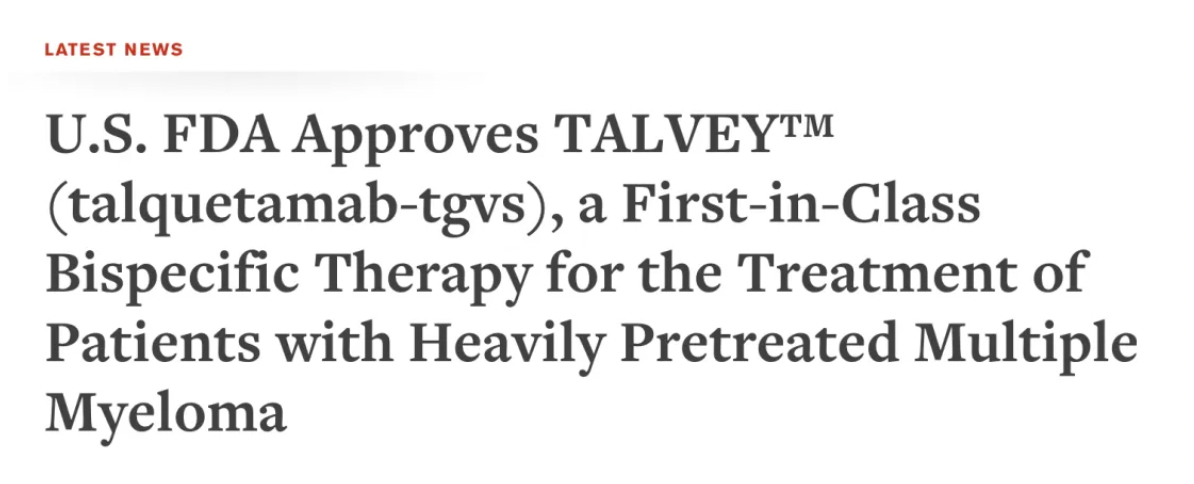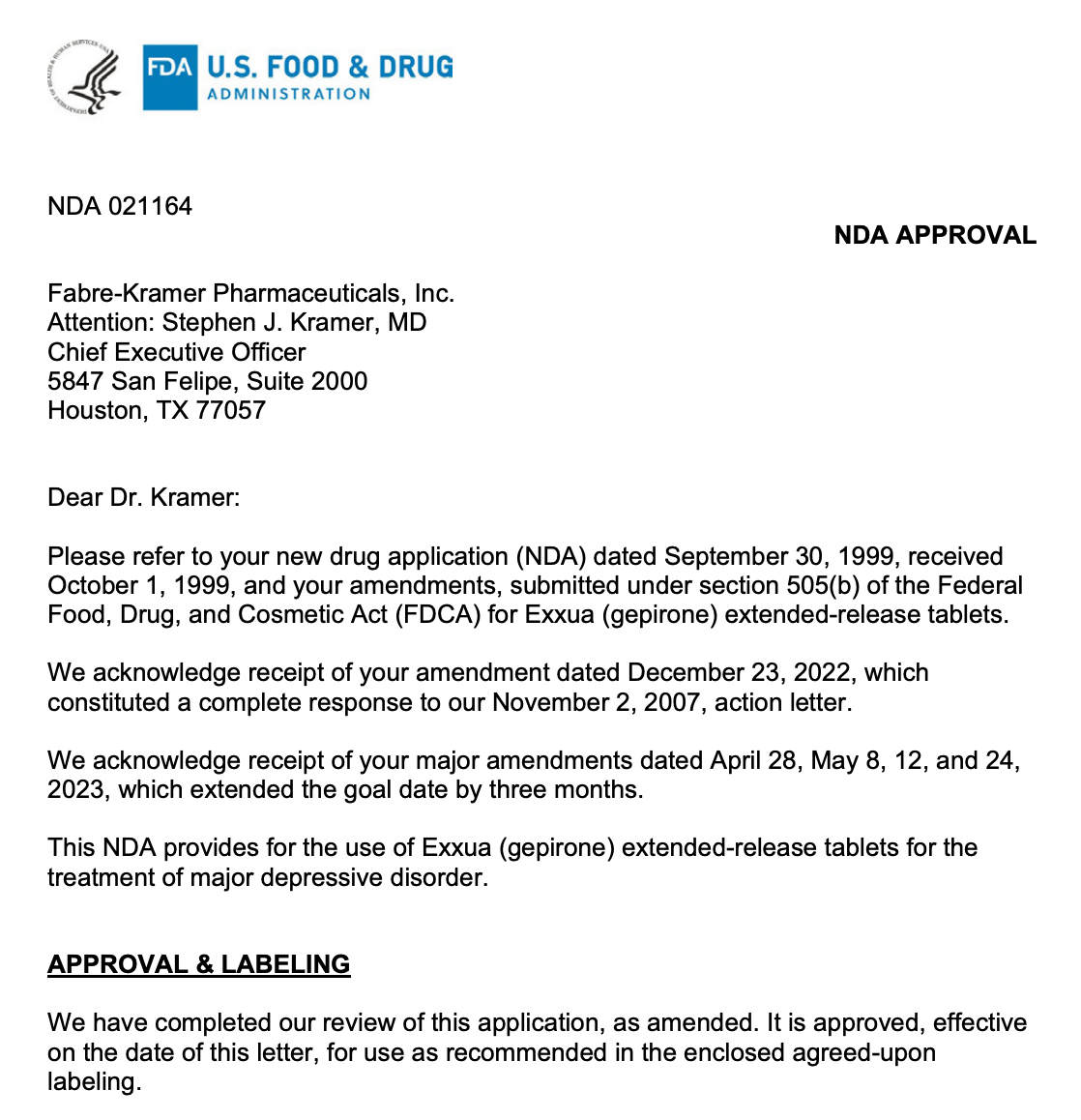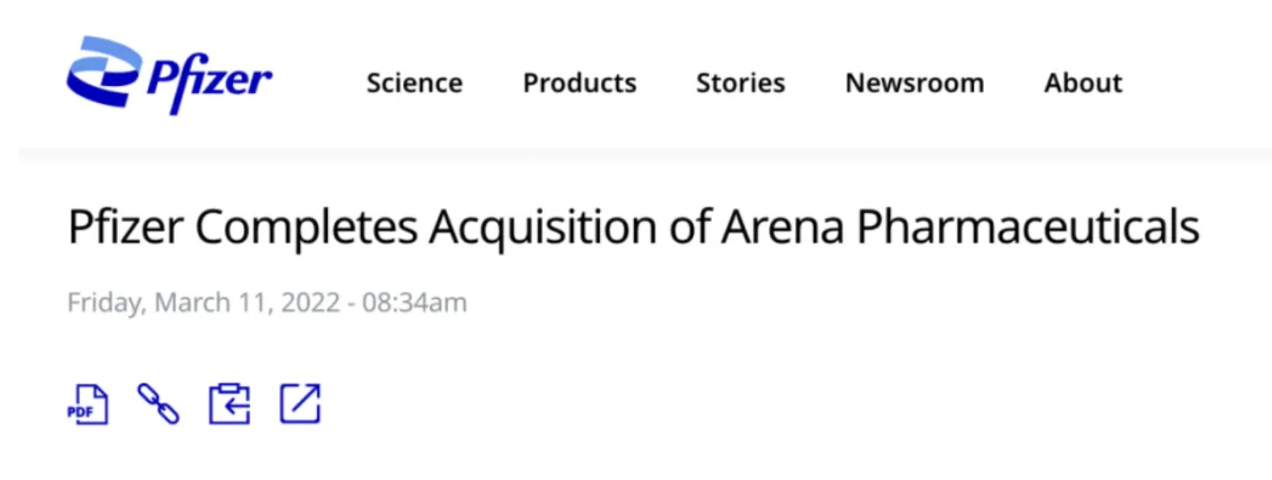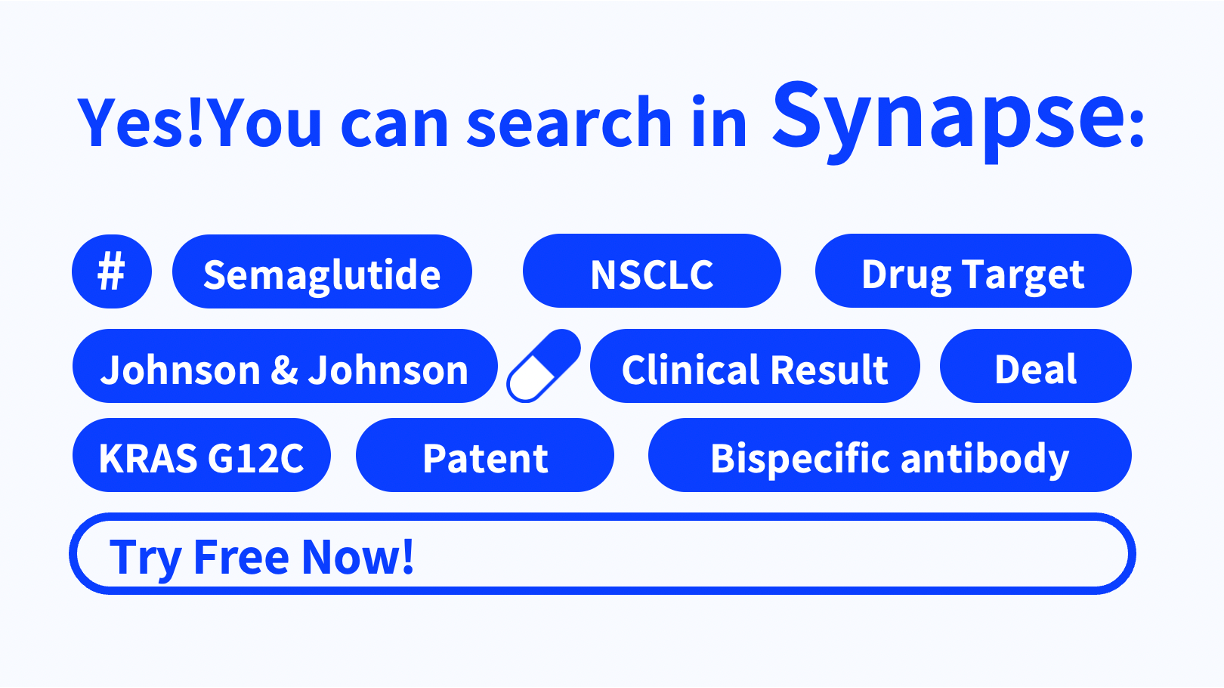2023 FDA-Approved GPCR-Targeted New Drugs Roundup
This article will introduce the new GPCR-related drugs approved by the FDA in 2023.
Filspari (Sparsentan)
On February 17th, 2023, Travere Therapeutics' Filspari (Sparsentan) is a dual antagonist of the endothelin A receptor (ETAR) and the angiotensin II (Ang II) type 1 receptor (AT1R), exhibiting high-affinity binding to both receptors (with an affinity of 9.3 nM for ETAR and 0.8 nM for AT1R). This drug is indicated for adults with primary IgA nephropathy (IgAN) who may experience rapid progression of the disease, and it can reduce proteinuria.
Endothelin-1 and angiotensin II are part of the pathogenesis of IgA nephropathy (IgAN), a disease characterized by an increase in antibodies against galactose-deficient IgA1 (Gd-IgA1). Antibodies to Gd-IgA1 can lead to mesangial cell activation and proliferation, thus stimulating the production of ET-1 and Ang II. As a dual antagonist of AT1R and ETAR, Sparsentan can reduce proteinuria in patients with IgAN. The selectivity of Sparsentan for ETAR and AT1R is more than 500-fold higher than for the type B endothelin receptor and the subtype 2 of the angiotensin II receptor.
On May 13th, 2023, the renowned medical journal The Lancet online published the results of Travere's clinical study on Sparsentan in patients with IgA nephropathy. The findings showed that, compared to the monotherapy with AT1R antagonist irbesartan, daily treatment with the dual-acting agent Sparsentan significantly reduced proteinuria in adult patients with IgA nephropathy.
Zavzpret(zavegepant)
On March 10, 2023, the U.S. Food and Drug Administration (FDA) approved Pfizer's new medication, Zavegepant (Zavzpret), for the treatment of acute migraine. Zavzpret is the world's first and only calcitonin gene-related peptide (CGRP) receptor antagonist nasal spray, indicated for the acute treatment of migraine in adults.
According to the pivotal Phase 3 study data released by the company, Zavzpret demonstrated statistically superior results compared to placebo on the twin primary endpoints of pain freedom and freedom from the most bothersome symptom at two hours post-dosing. Additionally, in the predefined secondary endpoints, Zavzpret provided the earliest pain relief, starting at 15 minutes, compared to the placebo.
Veozah (fezolinetant)
On May 12, 2023, the FDA approved the New Drug Application (NDA) submitted by Astellas Pharma US, Inc. for the commercialization of Veozah (fezolinetant). Veozah is an orally administered medication designed to treat moderate to severe vasomotor symptoms associated with menopause, such as hot flashes. This marks the first FDA-approved Neurokinin 3 (NK3) receptor antagonist for the treatment of moderate to severe hot flashes due to menopause. It functions by binding to NK3 receptors and blocking their activity.
On April 1, 2023, the internationally renowned medical journal "The Lancet" published a clinical research paper titled "Fezolinetant for treatment of moderate to severe vasomotor symptoms associated with menopause (SKYLIGHT 1): a phase 3 randomized controlled study," which demonstrated the therapeutic effectiveness of Fezolinetant on moderate to severe hot flashes.

Fezolinetant is among the first batch of non-hormonal NK3 receptor antagonists developed for the treatment of vasomotor symptoms during menopause. NK3 receptor antagonists are potential non-hormonal therapies for treating vasomotor symptoms in menopausal women. For those women who cannot or do not wish to undergo hormone therapy, this type of therapy represents a scarce option.
IZERVAY(avacincaptad pegol)
On August 4, 2023, the FDA approved IZERVAY™ (avacincaptad pegol) for the treatment of geographic atrophy (GA) secondary to age-related macular degeneration (AMD). IZERVAY is a novel complement C5 inhibitor and is the only approved treatment for GA. In the 12-month primary endpoints of two Phase III clinical trials, IZERVAY demonstrated a significant reduction in the progression rate of geographic atrophy.
Avacincaptad pegol is an RNA aptamer covalently linked to branched polyethylene glycol (PEG) molecules, which binds to the complement protein C5 and inhibits its activity. By inhibiting C5, avacincaptad pegol prevents its cleavage into C5a and C5b, thereby reducing the formation of the membrane attack complex (MAC).
According to the patent description related to Avacincaptag pegol, Avacincaptag pegol (research code ARC1905) is an aptamer molecule composed of a 39-nucleotide long RNA molecule and a 43 kD branched PEG. The amine group at the 5' end of the RNA molecule provides a chemical reactive group for pegylation.
TALVEY™ (talquetamab-tgvs)
On August 9th, Johnson & Johnson announced that the U.S. FDA approved TALVEY™ (talquetamab-tgvs) for the treatment of adult patients with relapsed or refractory multiple myeloma.

Talquetamab is a bispecific T-cell engager antibody targeting both the CD3 receptor on T cells and GPRC5D. GPRC5D is a novel therapeutic target belonging to the Class C group of G protein-coupled receptors, which is expressed on some normal cells but overexpressed in myeloma cells.
In December 2022, the Johnson & Johnson team published their first article in The New England Journal of Medicine, presenting the phase 1 clinical study results of the GPRC5D bispecific antibody Talquetamab, used for the treatment of multiple myeloma.
The results showed that 232 patients received talquetamab treatment (102 intravenously, 130 subcutaneously). The median follow-up time was 11.7 months for patients receiving a 405 microgram dose and 4.2 months for those receiving an 800 microgram dose, with response rates of 70% and 64%, respectively. The median durations of response were 10.2 and 7.8 months, respectively.
Common adverse reactions for the two subcutaneous dosing regimens (weekly 405 mcg/kg and biweekly 800 mcg/kg) included cytokine release syndrome (CRS) in 77% and 80% of patients, respectively, skin-related events in 67% and 70%, and oral ulcers in 63% and 57%. Except for one case of CRS, all other adverse reactions were Grade 1 or 2.
According to information from Johnson & Johnson's official website, the FDA submission included the latest clinical study data. The phase 2 MonumenTAL-1 study of Talquetamab included patients (187 individuals) who had at least four prior lines of therapy and had not received prior T cell redirecting therapy, showing a meaningful Overall Response Rate (ORR). At a subcutaneous (SC) dosing of 0.8 mg/kg biweekly, 73.6% of patients achieved ORR. During a median follow-up of nearly 6 months (range 0 to 9.5 months) after the first response, 58% of patients achieved a Very Good Partial Response (VGPR) or better, with 33% achieving a Complete Response (CR) or better.
At a weekly SC dose of 0.4 mg/kg, 73.0% of patients achieved ORR. During a median follow-up of nearly 14 months (range 0.8 to 15.4 months) after the initial response, 57% of patients achieved VGPR or better, of which 35% achieved CR or better.
Notably, the safety profile of TALVEY™ includes a "Boxed Warning" for cytokine release syndrome and neurotoxicity. The "Warnings and Precautions" include oral toxicity and weight loss, infections, cytopenias, skin toxicity, hepatotoxicity, and embryo-fetal toxicity. The most common adverse reactions (≥20%) were pyrexia, CRS, dyspepsia, nail disorder, musculoskeletal pain, skin disorder, rash, fatigue, weight loss, dry mouth, skin dryness, dysphagia, upper respiratory tract infection, diarrhea, hypotension, and headache. The most common Grade 3 or 4 laboratory abnormalities (≥30%) were lymphocyte count decrease, neutrophil count decrease, white blood cell decrease, and hemoglobin decrease.
Veopoz (pozelimab)
On August 18, 2023, Regeneron Pharmaceuticals, Inc. announced that the U.S. FDA has approved pozelimab (Veopoz™) for the treatment of CHAPLE disease, also known as CD55 deficiency with protein-losing enteropathy, in adults and children aged one year and older. Pozelimab is currently the first and only treatment specifically developed for CHAPLE disease.
CHAPLE disease is an ultra-rare, life-threatening genetic immune disorder caused by an overactivation of the complement system. For healthy individuals, the complement system is a mechanism that helps eliminate microbes. However, patients with CHAPLE disease have mutations in the CD55 gene which render them unable to regulate complement activity. Without proper regulation by CD55, the complement system may attack normal cells, damaging blood and lymphatic vessels in the upper gastrointestinal tract, leading to the loss of circulating proteins. Less than 10 cases of CHAPLE disease have been identified in the United States.
Pozelimab (REGN3918) is a fully humanized IgG4 monoclonal antibody developed by Regeneron Pharmaceuticals that binds with high affinity to C5 and its variants.
In May 2020, the Regeneron team published preclinical study results for the first time in the journal PLOS One, reporting findings from studies on humanized C5 mice and the discovery using fully human anti-C5 antibodies. A series of full-length antibodies were identified, which bind with high affinity to human and monkey-derived C5 without interacting with mouse C5. Pozelimab (REGN3918) binds with high affinity to C5 and its variants and effectively blocks complement-mediated hemolysis in vitro.
APHEXDA™(motixafortide)
On September 11, 2023, BioLineRx announced that the U.S. FDA has approved APHEXDA™ (motixafortide) for use in combination with filgrastim (G-CSF) to mobilize hematopoietic stem cells to peripheral blood for collection in patients with multiple myeloma, facilitating autologous stem cell transplantation.
Motixafortide is a high-affinity, long-acting synthetic peptide antagonist of CXCR4 (BKT-140), originally developed by Biokine Therapeutics, which later licensed it to BioLineRx for joint clinical development (BL-8040).
Motixafortide takes advantage of the expression of CXCR4 receptors on different immune cells to enhance the immune system's anticancer capabilities. Among immune cells that express CXCR4, some have anticancer activity, such as effector T cells, while others promote tumor growth and support its survival. By blocking the infiltration of immune suppressive cells mediated by CXCR4, motixafortide alleviates immune suppression.
Filgrastim (G-CSF) is a short-acting recombinant non-glycosylated human granulocyte colony-stimulating factor (G-CSF) analog produced via DNA recombinant technology, which has been approved for inducing granulocyte production and reducing the risk of infection following myelosuppressive therapy. Filgrastim's various therapeutic uses include treatment and prevention of infections as well as febrile neutropenia in patients undergoing myelosuppressive chemotherapy or radiotherapy. It is also used to control severe chronic neutropenia and to mobilize hematopoietic stem cells in peripheral blood for leukapheresis in patients undergoing peripheral blood stem cell collection and therapy.
Exxua (Gepirone)
On September 28th, 2023, Fabre-Kramer Pharmaceuticals announced on its official website that the U.S. Food and Drug Administration (FDA) had approved Gepirone Hydrochloride Extended-Release Tablets (brand name Exxua). Exxua is the first and only FDA-approved oral antidepressant that selectively agonizes the 5HT1a receptor. It works by modulating the activity of serotonin in the central nervous system and is indicated for the treatment of major depressive disorder (MDD) in adults.
The company first submitted a New Drug Application (NDA) for Gepirone Hydrochloride in September 1999, but it was initially rejected by the FDA in 2002. After three subsequent rejections, Exxua was finally approved after 24 years of rigorous review.
Below is an excerpt from the letter the FDA sent to Fabre-Kramer following the approval of Exxua:

Gepirone (BMY-13805), a selective small molecule partial agonist targeting the 5-HT1A receptor, was developed by Bristol-Myers Squibb and licensed to Fabre-Kramer Pharmaceuticals in 1993.
Fabre-Kramer submitted its marketing application in 1999. The U.S. FDA rejected the marketing applications for Gepirone in 2002 and again in 2004.
In May 2007, after providing extra information from clinical trials, Fabre-Kramer submitted the NDA once more. However, in 2012, Fabre-Kramer was unsuccessful in convincing the FDA of Gepirone's efficacy for anxiety and depression. In December 2015, the FDA gave a negative evaluation of Gepirone's efficacy in treating depression due to concerns over its effectiveness. Nevertheless, in March 2016, the FDA reversed its decision, providing a positive evaluation for Gepirone Extended-Release Tablets.
According to two key updated 8-week randomized, double-blind, placebo-controlled clinical studies, studies 134001 and FKGBE007, utilizing the improvement in the total scores on the Hamilton Depression Rating Scale (HDRS-17 or HAMD-17), Exxua was shown to be superior to placebo, confirming its efficacy in treating MDD.
Based on the primary efficacy endpoint of improved HAMD-17 scores, Exxua's effects were generally observed starting from the second week, with its antidepressant effects increasing over the subsequent weeks. The full manifestation of Exxua’s effects generally occurs by the third week or later.
VELSIPITY (etrasimod)
On October 12th, 2023, the U.S. Food and Drug Administration (FDA) approved Pfizer's new drug VELSIPITY™ (etrasimod) for the treatment of moderate to severe ulcerative colitis. Etrasimod is an orally administered, once-daily selective sphingosine 1-phosphate (S1P) receptor modulator with a recommended dose of 2 mg.
Etrasimod was originally developed by Arena Pharmaceuticals. In 2022, Pfizer announced a $6.7 billion acquisition of Arena Pharmaceuticals, with the aim of adding their clinical candidate for the treatment of moderate to severe ulcerative colitis to their portfolio.

Zilbrysq (zilucoplan)
On October 17th, 2023, the U.S. FDA approved UCB's Zilbrysq (zilucoplan) for the treatment of adult patients with generalized Myasthenia Gravis (gMG) who are anti-acetylcholine receptor (AChR) antibody positive. Generalized Myasthenia Gravis is an autoimmune disease characterized by the presence of pathogenic autoantibodies that bind to AChRs. Zilucoplan is a synthetic macrocyclic peptide consisting of 15 amino acids and acts as a complement inhibitor, preventing the activation of the complement protein C5, which plays a role in initiating inflammatory responses within the innate immune system. The precise mechanism of action of Zilucoplan in generalized Myasthenia Gravis has not been fully elucidated.




